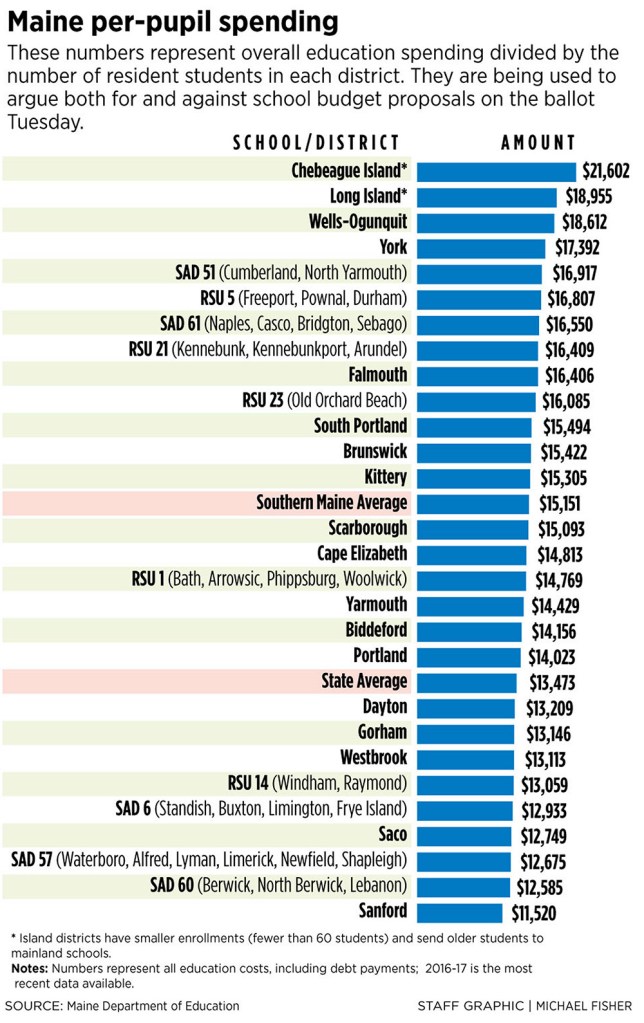Maine voters are about to decide the fate of local school budgets, and one statistic – per-pupil spending – is being used as ammunition in debates around the state, both by “yes” voters and “no” voters.
Data collected by the state shows school districts in southern Maine spent between $11,000 and $21,000 on each student in the 2016-17 school year, the most recent available. The average student in southern Maine cost $15,151 to put through public school that year.
The numbers are based on simple math: Add up all education costs, including transportation and debt payments, and divide it by the number of resident students in the district.
Some consider per-pupil spending to be a fair way to compare districts, and to decide whether or not to support local requests for more money. Others, however, say it’s a number that lacks context.
“They try to do apples-to-apples comparisons, and sometimes that is difficult,” said Steve Bailey, executive director of the Maine School Superintendents Association.
The reasons for higher spending per pupil are varied. Rural districts might spend more money on transportation. A district might have a higher population of special education students or English language learners, increasing overall per-pupil costs. The budget might include a career and technical education center. Isolated schools on islands or peninsulas have small enrollments, which might skew the ratio.
For example, Long Island and Chebeague Island spent more than $18,000 per student, putting them at the top end of the spectrum in southern Maine. Those island districts had fewer than 60 students each, while mainland districts typically have well over 1,000 and can therefore spread out their costs on a per pupil basis.
In School Administrative District 51, which serves Cumberland and North Yarmouth, critics have pointed to high per-pupil spending as evidence the budget is too high. The district spent $16,917 per student last year, the fifth-highest amount in the area.
Superintendent Jeff Porter said that argument is not a fair one. SAD 51 spends more money on special education than other districts, he said, which impacts the calculation.
“It’s so artificial,” he said. “It just does not tell the story.”
Porter said he uses a different number in his budget presentation. He removes state funding from the equation and compares districts based on money raised through property taxes. In SAD 51, the tax needs per student would be slightly more than $12,000 next year. He does the same calculation for the school districts he considers similar to his own – Yarmouth, Falmouth and Cape Elizabeth. In that lineup, he said, SAD 51 ranks third of four, spending less than Cape Elizabeth and Falmouth.
“To me, it’s more genuine in terms of what we’re actually asking taxpayers to do,” Porter said.
In the Gorham School District, on the other hand, officials hoping to pass their school budget have argued that the amount of money spent per pupil is a helpful point of reference.
The budget proposed for next year is a $1.3 million, or 3.5 percent, increase over the current year. It would add more than $1 per $1,000 of assessed property value to the tax rate.
 But Superintendent Heather Perry said that increase is a result of increasing enrollments and decreasing state aid. And she point to Gorham’s relatively low per-pupil spending as evidence that the district is financially responsible.
But Superintendent Heather Perry said that increase is a result of increasing enrollments and decreasing state aid. And she point to Gorham’s relatively low per-pupil spending as evidence that the district is financially responsible.
Perry said it is difficult to make comparisons, especially financial ones, across school districts. But she does want residents to see that the district’s per pupil costs are in line with past years and lower than many nearby communities, despite the proposed tax rate increase.
Last year, state data shows, Gorham spent $13,059 per student, well below the southern Maine average and slightly less than the state average of $13,473. Next year, the projected budget would be $13,903 per student – still in the bottom half of communities in southern Maine.
“When we look at how efficient we are in our expenditures, that really is not the issue in Gorham,” Perry said. “The issue has much more to do with our loss of state subsidy.”
To Bailey, the director of the superintendents’ association, that is an appropriate use of the statistic. The needs of a district and individual circumstances should give context to the numbers, he said.
“It’s very difficult to make decisions purely on dollars and cents,” Bailey said.
Megan Doyle can be contacted at 791-6327 or at:
mdoyle@pressherald.com
Twitter: megan_e_doyle
Send questions/comments to the editors.


